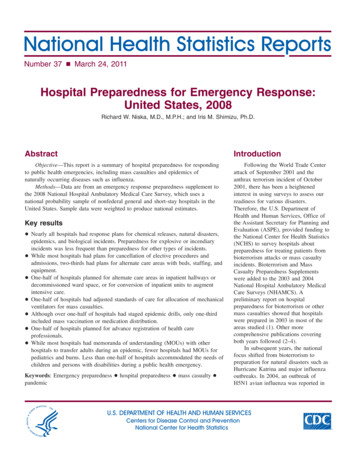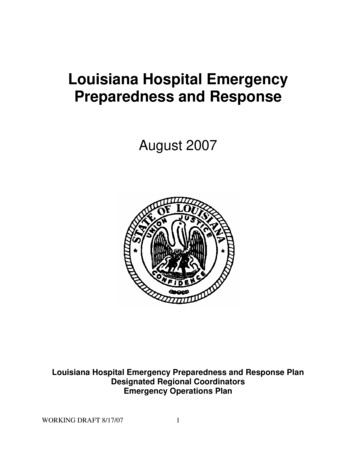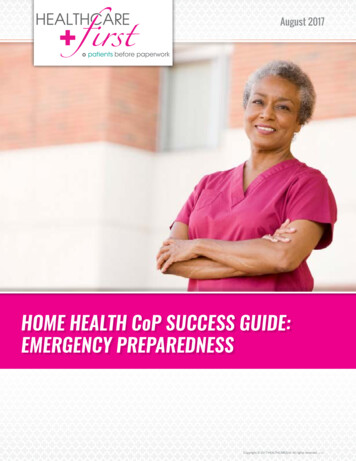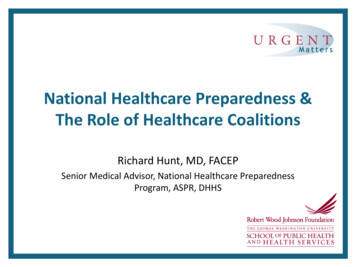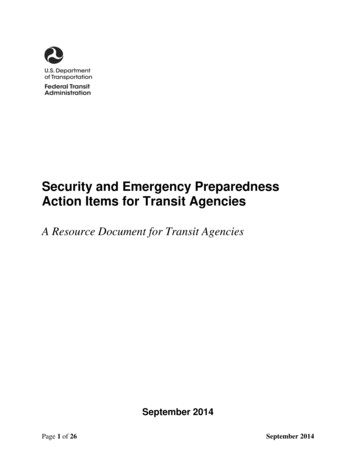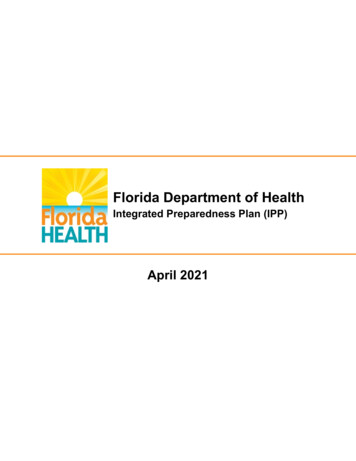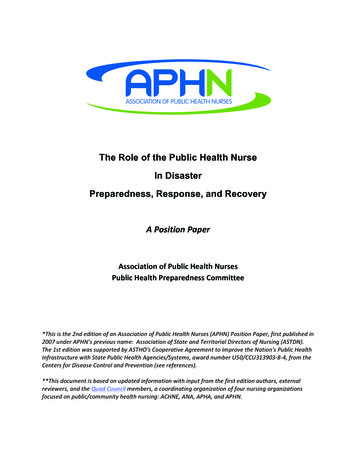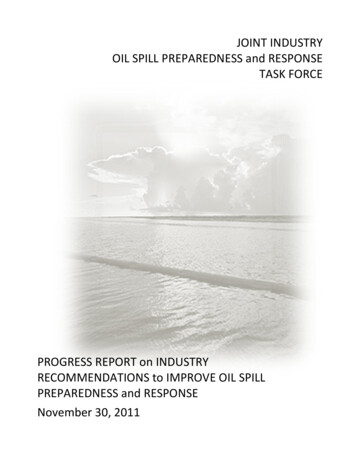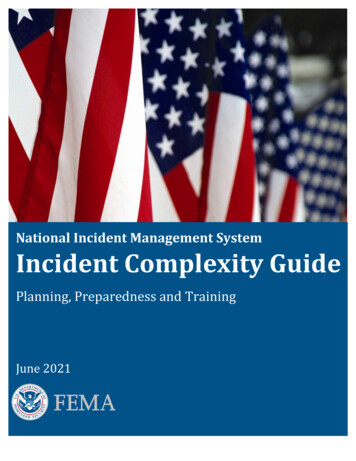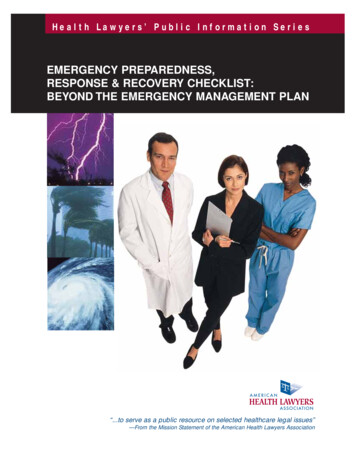
Transcription
Health Lawyers’ Public Information SeriesEMERGENCY PREPAREDNESS,RESPONSE & RECOVERY CHECKLIST:BEYOND THE EMERGENCY MANAGEMENT PLAN“.to serve as a public resource on selected healthcare legal issues”—From the Mission Statement of the American Health Lawyers Association
Copyright 2004 byAmerican Health Lawyers AssociationSecond reprint 2008. All websites have been updated as of April 1, 2008.This Checklist can be downloaded free of charge at www.healthlawyers.org/checklist. Other resources in the PublicInformation Series are available at www.healthlawyers.org/publicinterest/piseries.This publication may be reproduced in part or in whole without prior written permission from the publisher.Attribution to American Health Lawyers Association is requested.1025 Connecticut Avenue, NW, Suite 600Washington, DC 20036-5405Telephone: (202) 833-1100Facsimile: (202) 833-1105E-mail: info@healthlawyers.orgWebsite: www.healthlawyers.org“This publication is designed to provide accurate and authoritative information in regard to the subject matter covered. It is providedwith the understanding that the publisher is not engaged in rendering legal or other professional services. If legal advice or otherexpert assistance is required, the services of a competent professional person should be sought.”—-from a declaration of the American Bar Association
PREFACEThe American Health Lawyers Association’s (Health Lawyers) hopes that legal counsel will find EmergencyPreparedness, Response & Recovery Checklist: Beyond the Emergency Management Plan (Checklist) to be a useful and practice tool in identifying the key legal and operational issues arising in the event of a public health crisis, terroristthreat, environmental disaster or other emergency situation; it is our hope that the Checklist will help facilitate ahealth care provider’s emergency preparedness planning. Health Lawyers believes that healthcare executives,governing bodies, medical staff and other health professionals, and community leaders also will benefit fromfamiliarizing themselves with the legal and operational issues that arise during emergency situations.Health Lawyers’ Public Information Series is one of a variety of public interest activities that arise from the thirdelement of the Association’s mission statement, which pledges us “ . . . to serve as a public resource on selectedhealthcare legal issues.” Health Lawyers’ recently broadened its public interest role, which previously emphasized health policy related activities, to include activities through which the Association can serve as a publicresource on health law issues for certain legal services agencies and other non-profit organizations. Many members contribute pro bono services in their communities and find that it provides a fulfilling outlet by allowingthem to use their professional skills for the betterment of society. Broadening Health Lawyers’ public resourceoutreach initiatives is consistent with the Association’s desire to “give back” to society from our members’ legalexpertise. Health Lawyers plans to publish on a periodic basis informational resource guides related to healthlaw topics in the public interest or on pro bono matters and to make these complimentary guides available to certain legal services organizations and other non-profit organizations.The Public Information Series is one of a number of activities conducted by Health Lawyers and the PublicInterest Committee and is supported in part by generous donations from many Health Lawyers members, theirfirms and organizations. On behalf of the Public Interest Committee, I wish to thank all of the Health Lawyersmembers who made a contribution and ask members who may not have contributed in the past to considerdoing so.The Public Interest Committee extends its appreciation to Jeffrey M. Sconyers, Senior Vice President andGeneral Counsel of Children’s Hospital and Regional Medical Center, Seattle, WA; Blair Dobbins, formerDirector of Professional Resources at Health Lawyers; and Robert Truhn II, former Production Editor at HealthLawyers, for their invaluable assistance in the editing and production of this publication. The Public InterestCommittee also gratefully acknowledges the contributions of Montrece McNeill Ransom, Senior Public HealthAnalyst and Anthony D. Moulton, Ph.D., Director of the Public Health Law Program, U.S. Centers for DiseaseControl and Prevention, in reviewing and providing comments on this Checklist as well as furnishing selectedresources on public health partners.If you have suggestions for future publications in Health Lawyers’ Public Information Series, please contact KerryB. Hoggard, CAE, PAHM, Vice President of Membership and Public Interest, at (202) 833-0760 or khoggard@healthlawyers.org, or Katherine E. Wone, J.D., Manager of Public Interest, at (202) 833-0787 orkwone@healthlawyers.org.Elisabeth BelmontPresident, 2007-2008 American Health Lawyers AssociationTask Force Leader, Emergency Preparedness, Response & Recovery ChecklistChair, 2003-2005 Public Interest Committee
TABLE OF CONTENTSThe Emergency Preparedness, Response, and Recovery Checklist:Beyond the Emergency Management PlanI. Introduction .3VI. Finance (Green)Cash Flow .28II. Incident Command (Orange)Patient Insurance Coverage .28Emergency Management Plan .6Institutional Insurance Coverage .29Command Center .6Declaration of an Emergency or MajorDisaster, and Securing Disaster Funds .30Incident Commander .7Liaison Officer .8Public Information Officer .8VII. Recovery—Ending EmergencyCommunications Officer .8Operations .32Safety/Security Officer .9Recorder/Transcriber .9III. Operations (Red)Isolation and Quarantine .10VIII. Selected Resources .32Appendix A:Application of EMTALA During A Major PublicHealth Emergency .33Patient Diversion Issues .11Patient Tracking and Placement.12Reporting Requirements .13Appendix B:Personnel Issues.13Risk-Management Considerations.34Statutory and Regulatory Considerations .17Appendix C:IV. Planning (Blue)Securing Disaster Funding .36Corporate Governance.20Hazard Vulnerability Analysis .20Appendix D:Community-Support, Affiliation, and TransferAgreements.21Directories of State and Territorial PublicHealth Directors, State Public HealthLegal Counsel, and CDC EmergencyPreparedness Contacts.37Vendor Agreements .21Documentation .22Physical Plant and Facilities .23Appendix E:Civil Liability.23Selected Public Health EmergencyPreparedness Standards and Plans .37V. Logistics (Yellow)Personnel .24About the Authors .38Information Technology Infrastructureand Software Applications .25Developing Emergency Plans for IT Services.25Mitigation of ISP Failure .26Maintaining a Hot or Cold Site .261
EMERGENCY PREPAREDNESS,RESPONSE & RECOVERY CHECKLIST:Beyond the Emergency Management PlanElisabeth Belmont, EsquireBruce Merlin Fried, EsquireJulianna S. Gonen, EsquireI. INTRODUCTIONHealthcare professionals and organizations are recognized for their central and irreplaceable role in communities, particularly when natural disasters or otheremergencies occur. As ordinary citizens may go abouttheir business in the everyday setting, healthcareproviders must prepare routinely for a variety of emergency situations that may impair their ability to carefor patients on an ongoing basis.1 Many state laws andregulations require hospitals and other licensedhealthcare facilities to engage in emergency planningand drilling.2 Emergency preparedness, includingestablishing and maintaining an emergency management plan, also is one of the required seven disciplines of “Management of the Environment of Care”*1Anne M. Murphy, EsquireJeffrey M. Sconyers, EsquireSusan F. Zinder, Esquire*for organizations accredited by The Joint Commission(formerly The Joint Commission on Accreditation ofHealthcare Organizations).3 Healthcare providersexperience unexpected crises in different contexts,ranging from events where no essential hospital services are compromised to a disaster that affects all hospital operations on both large and small scales.Emergency events may be externally triggered (e.g.,natural disasters; outbreaks of new, deadly diseases; orvicious acts of terrorism) that result in a massivedemand on a healthcare system. Emergencies alsomay be entirely institution-based (e.g., a small fire inthe data center, a burst pipe in the emergency department, or a hospital-wide labor strike). Regardless ofwhether emergencies are external or internal to theorganization, such events may impair healthcare oper-The authors wish to express their sincere appreciation to Lori L. Buchsbaum, J.D. and Tisha Bai, J.D. for their assistance in preparingthis publication. Additionally, the authors wish to thank Lori H. Spencer, Esq. for her willingness to offer her perspective on certainpublic health law issues. For information about the authors, please see the end of this publication.The Model State Emergency Health Powers Act addresses a number of issues relating to public health emergencies, including: measures to detect and track potential and existing public health emergencies; declaring a state of public health emergency; special powersof governors and state public health authorities during a state of public health emergency (including control of property and persons);dissemination of information regarding public health emergencies; and planning for such emergencies. See THE CTR. FOR LAW AND THEPUBLIC’S HEALTH AT GEORGETOWN & JOHNS HOPKINS UNIVERSITIES, CTRS. FOR DISEASE CONTROL AND PREVENTION, THE MODEL STATEEMERGENCY HEALTH POWERS ACT (2001) [hereinafter MODEL STATE EMERGENCY HEALTH POWERS ACT (2001)]; THE DRAFT MODEL STATEEMERGENCY POWERS ACT, GUIDELINES FOR CONSIDERATION BY THE STATES (2001), available at www.nga.org/cda/files/EmerPowersAct.pdf(last visited April 1, 2008). The preamble to the Draft notes that “[b]ecause each state is responsible for safeguarding the health, security,and well-being of its people, state governments must be able to respond rapidly and effectively to potential or actual public healthemergencies.” Id. at 8. The Model Act therefore “grants specific emergency powers to state governors and public health authorities.”Id. Because public health laws vary from state to state, some states may consider enacting only certain portions of the Act.2See N.Y. COMP. CODES R. & REGS. tit. 10, § 702.7 (2004) (requiring emergency and disaster preparedness for all medical facilities); see alsoWASH. ADMIN. CODE § 246-320-405(5) (2004) (establishing conditions for hospital licensure including implementation of a disaster plan“designed to meet both internal and external disasters”).3See, e.g., THE JOINT COMMISSION, HOSPITAL ACCREDITATION STANDARDS (HAS) Standards EC4.10, EC4.20 (2004) (providing a detailedchecklist of required activities and requiring a hospital to conduct drills regularly to test emergency management). Cf. NATIONAL FIREPROTECTION ASS’N, STANDARD 1600 ON DISASTER/EMERGENCY MANAGEMENT AND BUSINESS CONTINUITY PROGRAMS §§ 1.1, 1.2 (2004) (establishing a standard common set of criteria for assessing and implementing emergency and disaster management), available atwww.nfpa.org/PDF/nfpa1600.pdf (last visited April 1, 2008).3
ations and thereby trigger the implementation of ahospital’s emergency management plan and itsIncident Command Structure (ICS) or HospitalEmergency Incident Command System (HEICS)4response.For example, Tropical Storm Allison created such anemergency situation for the Memorial HermannHealthcare System in June 2001, when downtownHouston, TX, and the hospital endured more thantwenty inches of rain in a three-day period. The flooding water overwhelmed precautions that had beendesigned to withstand a 100-year flood; destroyed apathology laboratory; dispersed medical waste andbiohazards; submerged mechanical, electrical, andplumbing systems; damaged communication systems;and required the complete evacuation of theMemorial Hermann Hospital and the MemorialHermann Children’s Hospital.5And, of course, all Americans remember the heroismand professionalism exhibited by healthcare workers inthe hours and days after the terrorist attacks in NewYork, NY, and Washington, D.C., on September 11,2001. Or consider the example of the North YorkGeneral Hospital in Toronto, Canada, which experienced a different emergency situation during May andAugust of 2003, when an outbreak of Severe AcuteRespiratory Syndrome (SARS) occurred in its orthopedic unit.6 The hospital ultimately had ninety SARSpatients, forty-four of them from the hospital’s staff.North York General closed its doors to any newpatients, and had to find ways to treat those patientswho already had or who developed SARS. Hospital staffassumed significant personal risk to treat a new type ofdisease that affected their friends and colleagues. Theydid so under extraordinarily difficult circumstances thatincluded a workplace quarantine and the intense scrutiny of a frightened media and populace.7Remember also that, in the summer of 2003, largeportions of New England and the mid-Atlantic states4suffered power outages as a result of a falling treelimb cutting power lines in Ohio. Community members flocked to hospitals across the region for sheltereven as the hospitals were operating on emergencygenerator power, canceling elective procedures, andfrequently functioning with compromised computerand other systems. As recently as late summer of 2004,four hurricanes devastated the state of Florida, causing the evacuation of local hospitals.Accordingly, it is vitally important that healthcareproviders maintain a constant state of emergency preparedness to ensure appropriate response and recovery within the quickest possible timeframe. Such preparedness encompasses four phases: (i) preparation;(ii) mitigation; (iii) response; and (iv) recovery.8Without proper planning, a crisis for the provider mayresult in unintended consequences involving a potential temporary or permanent business failure, thusadding a crucial community institution to the list ofthe event’s casualties. The purpose of this Checklist is toidentify the key legal and operational issues arising inan emergency in order to enhance a healthcareprovider’s emergency preparedness9 by demonstratingthe connection between emergency-planning activitiesand routine planning, contracting, and operationalfunctions. By considering the following points, ahealthcare provider will be in a better position to promote success for the organization as it confronts unexpected events.This Checklist should not be construed as legal advice,however, and does not purport to encompass all possible legal and other issues that may apply in the eventof such an emergency situation; each crisis presents itsown unique circumstances. Finally, not every crisis willtrigger all of the issues identified in this Checklist.Additionally, public health emergencies have thepotential for far-reaching effects on the U.S. population at large, and thus pose unique legal and operational issues for local health systems. A public health4See NORTH CAROLINA HOSP. ASS’N, HOSPITAL EMERGENCY INCIDENT COMMAND SYSTEM (1992) (discussing both the Incident CommandSystem and Hospital Emergency Incident Command System disaster response plans).56Juanita F. Romans, Tropical Storm Allison: The Houston Flood of June 9th, 2001, 6 THE INTERNET JOURNAL OF RESCUE AND DISASTER MEDICINE(2002), at www.ispub.com/ostia/index.php?xmlFilePath journals/ijeicm/vol6n1/coo.xml (last visited April 1, 2008).See Susan Kwolek, Lessons Learned from SARS: The Story of North York General Hospital, in AM. HEALTH LAW. ASS’N, SARS: LEGAL AND RISKMANAGEMENT LESSONS LEARNED FROM TORONTO TO ATLANTA TELECONFERENCE (Nov. 13, 2003).7Id.89NATIONAL FIRE PROTECTION ASS’N, supra note 3, § 5.1.2.For additional information relating to operational issues, please see the following websites: Am. Hosp. Ass’n, Disaster Readiness, atwww.hospitalconnect.com/aha/key issues/disaster readiness/index.html (last visited April 1, 2008); Ctrs. for Disease Control andPrevention, Emergency Preparedness and Response, at www.bt.cdc.gov (last visited April 1, 2008); Greater New York Hosp. Ass’n(GNYHA), GNYHA Emergency Preparedness Resource Center, at www.gnyha.org/eprc (last visited April 1, 2008); Nat’l Disaster Med.Sys., at oep-ndms.dhhs.gov (last visited April 1, 2008); RAND Ctr. for Domestic and Int’l Health Security, What’s New, atwww.rand.org/health/centers/healthsecurity/ (last visited April 1, 2008).
INTRODUCTIONemergency, as defined in the Model State EmergencyHealth Powers Act, is anoccurrence or imminent threat of a health condition caused by bioterrorism or the appearance of a novel or previously controlled or eradicated infectious agent or biological toxin, andposes a high probability of a large number ofdeaths, serious long-term disabilities, or significant risk of substantial future harm in the affected populations.10The challenges inherent in quickly identifying the disease agent, mode of transmission, and best treatmentoptions significantly affect both the well-being ofhealthcare workers and the daily operations of healthcare facilities. This is true particularly in the event thatit becomes necessary for the public health authority toassume control of a hospital.True community-wide emergency preparedness therefore hinges on close coordination and cooperationbetween public health agencies, healthcare organizations, and their respective legal counsel. Protectingcommunities from man-made and naturally occurringthreats alike requires legal counsel—for both publichealth agencies and healthcare providers—to establish a clear understanding of legal roles and operational responsibilities of each party, well in advance ofany public health emergency. This is important particularly to minimize the loss of lives and reduce thepotential economic consequences of these events. Tofurther this goal, the U.S. Centers for Disease Controland Prevention’s (CDC’s) Public Health Law Programhas developed the Community Public Health LegalPreparedness Initiative (Initiative).11 Through intensive, community-based, one-day workshops, thisInitiative aims to build vibrant and enduring partnerships between legal counsel for private and public hospitals, as well as with other healthcare organizationsand public health agencies, to enhance the use of lawas a tool to advance community health through prevention and health promotion. Resources to facilitatethis public health/healthcare partnership are listed inAppendices D and E of this Checklist.This Checklist is organized to reflect the hierarchyestablished by the ICS structure, which provides a scalable approach to emergency management. The ICSstructure offers a model for the immediate (and hopefully short-term) ad hoc restructuring of an organization around functional (rather than administrative)lines to better meet the demands of a given emergency situation. ICS identifies key roles within anorganization, addresses responsibilities for each role,and assigns individuals and resources to those rolesbased on their availability as needed during an emergency. The ICS structure is scalable, enabling its use inthe full range of emergency situations that may disrupt a healthcare provider’s operations. The ICSemploys an “Incident Commander” with four “sections” that report to the commander: (i) Operations;(ii) Planning; (iii) Logistics; and (iv) Finance, eachwith its own “chief.”1210 MODEL STATE EMERGENCY HEALTH POWERS ACT (2001), supra note 1.11 See FIRESCOPE CALIFORNIA, GLOSSARY OF TERMS (ICS 010-1) 11 (1999), available at www2.cdc.gov/phlp/prepinitiative.asp (last visited April1, 2008) [hereinafter GLOSSARY OF TERMS]. For more information about the Community Public Health Legal Preparedness Initiative andthe Workshop Director’s Guide, please visit www2.cdc.gov/phlp/prepinitiative.asp (last visited April 1, 2008) or contact the CDC PublicHealth Law Program (Telephone: 770-488-2886, Fax: 770-488-2420; e-mail dreid@cdc.gov).12 By custom in the healthcare environment, each of these five key roles (i.e., the Incident Commander and her/his four Chiefs) has anassigned color, as indicated below. See NORTH CAROLINA HOSP. ASS’N, supra note 4, for an organizational chart showing these four divisions.5
II. Incident Command (Orange)The Incident Commander has overall authority andresponsibility for operations during an emergencyevent.13 The Incident Commander’s main job is toallocate resources and ensure safety. Any function nototherwise assigned also is the responsibility of theIncident Commander. In addition to the four identified Incident Command System roles, the IncidentCommander has direct reports from the LiaisonOfficer, Public Information Officer (PIO),Communications Officer, Safety/Security Officer,14and Recorder/Transcriber.A. Emergency Management PlanIt is critical for the organization’s personnel and medical staff to be familiar with its emergency management plan and ICS. In particular, personnel and medical staff should be aware of the following:1. What constitutes a disaster that could trigger theimplementation of the organization’s emergencymanagement plan and how is a disaster declaredby the facility?2. What code is called via the overhead paging system to announce the disaster and trigger implementation of the institution’s emergency management plan?3. Where is the organization’s staff to report afteran emergency is declared, and how will theorganization account for their location? How willstaff member locations be recorded (e.g., bysign-in sheet)?a. Where is the institution’s Command Centerprimarily located, and under what circumstances might it be moved to an alternatelocation? Is the Command Center appropriately outfitted, and is it available forimmediate use?b. What resources in the Command Centermight individual staff contribute as part ofplanning?i Are personal contact numbers for relevantstaff (e.g., home and cell telephones, personal fax number, e-mail address) available tothe Command Center?ii Are the personal contact numbers of contactsat governmental offices, sister institutions,and important vendors available to theCommand Center?4. Have the organization’s operations personnel been briefed with respect to the personal role and skills of individual staff, andhow may those individuals assist anIncident Commander coordinating aresponse to an emergency?5. Have personnel and medical staff membersbeen provided with information to enablethem to develop family emergency plans,so that they can be confident of their families’ safety while they fulfill their obligationsto respond during an emergency situation?B. Command CenterThe Command Center is the location from which theresponse to the emergency will be coordinated. Itneeds to be located and equipped in such a manneras to facilitate an appropriate response to the disaster,regardless of whether its scope is large or small.1. Has the institution established a formalCommand Center?2. In choosing a location, has the institution considered what types of emergencies to which theinstitution will need to respond, so that the center is located in an easily accessible location thatis close to the response, but not so close as to riskinterfering with it?153. Is the Command Center connected with theinstitution’s emergency generators?4. Is it properly equipped with the followingresources?a. Computers, e-mail, the organization’sintranet, Internet access, phones, pagers,radios, and other resources in order to fulfill an institution’s communication needs?b. Paper, pens, and markers for handwrittencommunication needs?c. Sufficient information about the institution’s resources (and made easily accessibleand searchable) to enable the functioning13 FIRESCOPE CALIFORNIA, FIELD OPERATIONS GUIDE (ICS 420-1) 5-2 (2004), available at pdf (last visited April 1, 2008) [hereinafter FIELD OPERATIONS GUIDE].14 See NORTH CAROLINA HOSP. ASS’N, supra note 4.15 For example, locating a command center in an emergency room that might have to deal with a mass casualty response may risk pullingpeople into the Emergency Department who will have administrative but not clinical responsibilities and so may inadvertently interferewith the response.6
INCIDENTINTRODUCTIONCOMMANDd. Easy access to institutional policies, boththose needed for routine operations (e.g.,Administration Policy and ProcedureManual, Medical Staff Bylaws) and any policies and procedures that have been adopted in anticipation of an emergency? Whatmechanism ensures that such policies arealways kept up to date? For example, doesthe Command Center have access to compliance policies with respect to the HealthInsurance Portability and AccountabilityAct (HIPAA) that describe how to respondto inquiries seeking information regardingthe location and condition of missing persons who may be patients?response to the emergency. In an institution thatimplements a classic ICS structure, the commanderrole may be filled by almost anyone in the institutionwho identifies and announces the emergency untilsuch time as someone in an administrative chain ofcommand superior to that person takes over the roleof Incident Commander.16 In a HEICS system, therole of Incident Commander may be filled by individuals who have pre-assigned roles that will automatically slot into the command structure. For example,the organization’s chief operating officer may automatically assume command for a hospital-wide emergency; by contrast, the Chief of Engineering mayassume command for responding to a broken pipethat floods the hospital’s data center. Regardless ofwhether the Incident Commander is in the institution’s organization chart, she is responsible for theresponse until relieved or the emergency ends.5. Can the Command Center be moved if circumstances require such action?1. Does the institution’s emergency plan call for theimplementation of an ICS or HEICS system?6. Is the Command Center scalable?2. If it is an ICS system, are all the potential individuals who may declare a disaster and assume command aware of their potential authority?a. Is it in a single room, or is it in a locationthat can be expanded?b. Is the location accessible to the senior management team?c. If the Command Center needs to beexpanded, has the institution determinedan alternate location? Is that alternate location connected to the emergency generatorsystem?d. Is the Command Center (or alternate location) capable of accommodating multiplepeople who are working multiple phonesand computers simultaneously for easy andimmediate communication among the ICSofficers and Section Chiefs?e. Is it close to—but separate from—a personnel staging area, so that the IncidentCommander and the Operations SectionChief may easily assign people awaitinginstruction, without having these peoplecrowd into the Command Center?7. Does the Command Center include easy accessto community and affiliate resources, includingall necessary contact information?C. Incident CommanderThe Incident Commander is the individual whoassumes overall authority for the institution’sORANGEof an Incident Commander who may beunfamiliar with the hospital’s major relationships and personnel?a. Are they trained in the emergency management plan?b. Do they understand how they may berelieved of responsibility?3. If an institution uses a HEICS system, are theindividuals who may assume command as aresult of their roles within the organizationaware of their roles and their responsibilities inan emergency? Could the designation of theIncident Commander change, based on thenature of an emergency?4. If the organization uses a HEICS structure (orother modified ICS structure that preassignsindividuals to roles in the incident commandstructure), is the structure regularly reviewedwhen individuals leave (and new individualsjoin) the organization, and are the assignmentsupdated as needed?5. Under either an ICS or HEICS of system:a. Does the relevant individual know the location of the Command Center and thepotential resources in it;b. Is that individual familiar with the institution’s resources to enable her to gather andassign resources as necessary; and16 A classic incident-command response may require an individual who is above the Incident Commander in the organization’s standardorganization chart to either assume command or become a direct report to the Incident Commander.7
c. Does some kind of chart exist that may bepopulated
The American Health Lawyers Association's (Health Lawyers) hopes that legal counsel will find Emergency Preparedness, Response & Recovery Checklist: Beyond the Emergency Management Plan (Checklist) to be a useful and prac-tice tool in identifying the key legal and operational issues arising in the event of a public health crisis, terrorist
